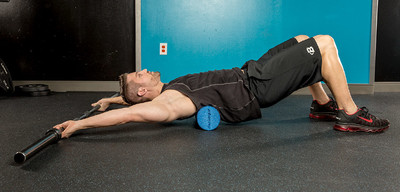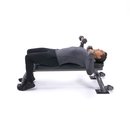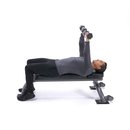What do the bench press, bent-over barbell row, overhead barbell press, and pull-up all have in common? If you answered that they comprise the most basic upper-body movements recommended by top trainers and fitness books for improving upper-body strength, then you've earned yourself a cookie.
While those exercises are staples in many strength programs, there's one minor detail that many people neglect to consider: shoulder health. The shoulders are heavily recruited for every one of these movements, and if your shoulder joints ain't up to snuff, these exercises could actually be causing you a lot more harm than good. I'll be taking back that cookie now.
In order for these exercises to be safe and effective, your shoulders (the glenohumeral joints) should easily move along their entire intended range of motion. Not everyone's do, however, due to a variety of reasons I'll get to in a moment. That's why it's not uncommon for some folks to injure themselves on the bench press, while others can seemingly lift three times their body weight with no problems.
If not properly addressed, reduced shoulder flexion range of motion and poor shoulder blade/shoulder joint coordination are common problems that can set you up for further shoulder joint issues. Don't worry, limited range of motion is not something you are forever stuck with.
I recommend a variety of mobility drills and a workout to improve it, but first, let's test the limits of your shoulder's range of motion.
Shoulder Flexion Range of Motion Test
Ideally, you should be able to bring your shoulder joint to 180 degrees of flexion to safely press or pull in the vertical direction. This can be assessed in two ways:

Shoulder flexion range of motion
Lie down with your back on the floor or stand with your back facing a wall. Set up by trying to straighten out, finding your neutral low back and pelvic position. Keep your rib cage in and brace your abdominals to maintain a neutral pelvis, spine, and rib position.
Exhale fully. With your arms straight, reach up and try to bring both arms to the sides of your ears.
If your arms can lay straight against the floor or wall without your ribcage flaring out or you arching your lower back, your mobility is great! If there's compensatory movement from your ribcage or lumbar to straighten out your arms, then it's advisable to avoid vertical pressing and pulling movements and work on your shoulder mobility.
Improving Shoulder Mobility
It's difficult to pinpoint any one thing that is limiting shoulder mobility. The more common diagnoses include tight muscles (usually the pec major and minor, lats, teres major, subscapularis, and rhomboids), bone-on-bone impingements, improper shoulder blade movement (scapular dyskinesis), or poor thoracic spine mobility, and all can contribute to limiting the shoulder's range of motion.
While it's difficult to provide an accurate diagnosis and appropriate intervention within the scope of this article, these mobility drills can help relieve a lot of common issues. Try adding these to your upper-body warm-up routine!
1. Thoracic Spine Roll-Out with Shoulder Flexion
Lie over a foam roller that's perpendicular to your spine—just underneath your shoulder blades—and place a barbell on the ground above your head. Reach for the barbell, as if making a Y with your arms. Keep your elbows straight. Place your feet flat on the floor and hold your hips in the air. Slowly exhale and lower your hips toward the floor.

Thoracic Spine Roll-Out with Shoulder Flexion
You should feel a stretch in front of your chest and your upper back extending. Pause for five seconds. Lift your hips and move the roller slightly closer to your shoulders. Lower your hips and pause again for five seconds. Perform with the roller at several locations on your upper back.
2. Modified Downward Dog
Get on your hands and toes with your hips in the air and knees slightly bent. Brace your abs and push your hips into the air. Feel as if you are trying to lengthen your spine. As this happens, gently push your chest toward your toes.

Modified Downward Dog
Visualize yourself forming a straight line from your arms to your tailbone while keeping your knees bent. Continue this process for one minute and notice the sensation in your lats and posterior shoulder.
3. Loosen Pecs and Lats
Recall that tight muscles can often be the culprit behind poor shoulder mobility. Soft tissue work via a softball, lacrosse ball, beastie ball, or foam roller can help alleviate a lot of the tension and improve overall mobility over time.

Lacrosse Ball Roll-out
To target the pecs, sandwich a lacrosse ball between your upper chest and a wall. Place pressure on the ball and slowly roll the ball over your pecs. For the lats, lie sideways over a foam roller. Slowly roll your body up and down the roller while the roller massages your posterior shoulder and lat muscles.

Lat Foam Roll
When you find a sensitive spot, stop and apply direct pressure until the tightness and pain slowly dissipates. Be sure to hit both sides.
4. Sphinx Pose with Anterior Reach
Weakness in the serratus anterior, a muscle involved in stabilizing your shoulder blade and its movement, can make it difficult to raise your arm during shoulder flexion. Improving this muscle's strength and function can greatly improve shoulder flexion range of motion.
Lie on your stomach and place your elbows and forearms on the ground as if propping up your upper body to watch TV. Imagine pushing your chest away from the ground, pushing your shoulder blades away from each other, and stretching your head upward. Maintain this position and reach one arm forward.

Sphinx Pose with Anterior Reach
Focus on keeping your shoulder blade in that position and holding a neutral torso position while reaching forward. Return the reaching arm to the starting position and reset your shoulder blades. Perform for reps for one minute and switch sides.
Shoulder Workout
This upper-body workout can be performed 1-2 times per week. In the first workout, perform the strength version; in the second workout, perform the hypertrophy version.
Separate the workouts by 3-4 days. These exercises were chosen specifically for their shoulder-friendly nature and will benefit anyone with shoulder issues.

BodyFit
$6.99/month- 2,500+ expert-created single workouts
- 3,500+ how-to exercise videos
- Detailed workout instruction
- Step-by-step workout tips
- Training at gym or at home
- Access to Workout Plans
- Access to Bodyfit App
- Store Discounts
Already have a Bodybuilding.com account with BodyFit? Sign In

What comes with BodyFit?

- Instructional Videos
Don't risk doing a workout improperly! Avoid injury and keep your form in check with in-depth instructional videos.

- How-to Images
View our enormous library of workout photos and see exactly how each exercise should be done before you give it a shot.

- Step-by-Step Instructions
Quickly read through our step-by-step directions to ensure you're doing each workout correctly the first time, every time.

BodyFit
$6.99/month- 2,500+ expert-created single workouts
- 3,500+ how-to exercise videos
- Detailed workout instruction
- Step-by-step workout tips
- Training at gym or at home
- Access to Workout Plans
- Access to Bodyfit App
- Store Discounts
Already have a Bodybuilding.com account with BodyFit? Sign In

What comes with BodyFit?

- Instructional Videos
Don't risk doing a workout improperly! Avoid injury and keep your form in check with in-depth instructional videos.

- How-to Images
View our enormous library of workout photos and see exactly how each exercise should be done before you give it a shot.

- Step-by-Step Instructions
Quickly read through our step-by-step directions to ensure you're doing each workout correctly the first time, every time.




